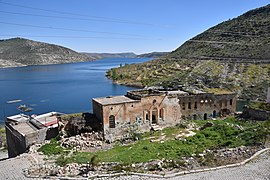Gümüşgün, Nizip
Gümüşgün | |
|---|---|
 The view of the Euphrates and the historic houses of Ehnesh | |
| Coordinates: 37°12′3″N 37°49′45″E / 37.20083°N 37.82917°E | |
| Country | Turkey |
| Province | Gaziantep |
| District | Nizip |
| Population (2022) | 60 |
| Time zone | TRT (UTC+3) |
Gümüşgün, historically Ehnesh or Ehneş, is a neighbourhood in the municipality and district of Nizip, Gaziantep Province, Turkey.[1] The village had a population of 60 in 2022.[2]
History
The village, along with the region, was initially inhabited by Syrian Jacobite Christians, who were deported by the Byzantines in 777 to various places including the Balkans and later Ramla in Palestine.[3] The region then experienced a demographic shift from Syrian to Armenian, and prior to the Armenian genocide, the village was entirely inhabited by Armenians.[4][5] In the 1930s, a rich Jewish landlord from Aintab possessed a lot of land in the village, which was noted as Kurdish.[6] The village is inhabited by Muhacir Turks from Thessaloniki who settled in the village after the Balkan Wars and the population exchange between Greece and Turkey.[7][4]
References
- ^ "Türkiye Mülki İdare Bölümleri Envanteri". T.C. İçişleri Bakanlığı (in Turkish). Retrieved 19 December 2022.
- ^ "Address Based Population Registration System (ABPRS) - Results of 31 December 2022" (XLS). TÜİK. Retrieved 12 March 2023.
- ^ Palmer 1993, p. 46.
- ^ a b Palmer 1993, p. 47.
- ^ Sarafean, Georg Avedis (1957). A Briefer History of Aintab A Concise History of the Cultural, Religious, Educational, Political, Industrial and Commercial Life of the Armenians of Aintab. Boston: Union of the Armenians of Aintab. p. 27. Retrieved 4 September 2022.
- ^ Şanlı, Süleyman (2019). Jews of Turkey: Migration, Culture and Memory. Routledge. p. 105.
- ^ "Gaziantep : Sular Altında Kalan Köy ve Şehirler". Bakmadan Gezme. 8 July 2021. Archived from the original on 2 August 2021. Retrieved 21 January 2023.
Bibliography
- Palmer, Andrew (1993). Hokwerda, Hero; Smits, Edmé Renno; Woesthuis, Marinus M. (eds.). "The Messiah and the Mahdi History Presented as the Writing on the Wall". Polyphonia Byzantina, Studies in Honour Of Willem J. Aerts. Groningen: Egbert Forsten: 45–84.
Further reading
- "Sarafian collection - Paris". Houshamadyan. Retrieved 1 May 2023.
